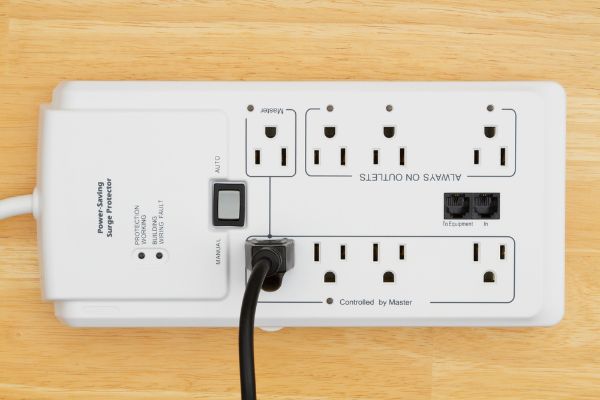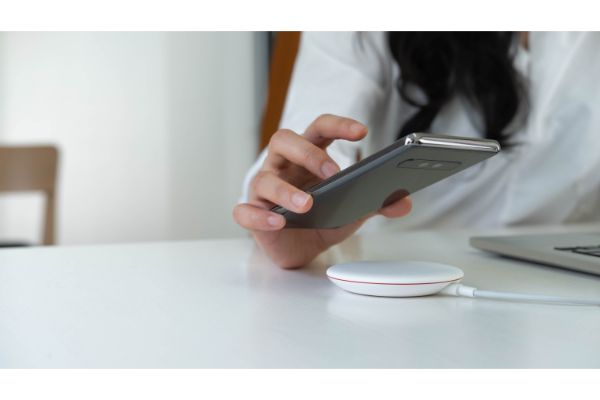Disclaimer: This post may contain affiliate links, meaning we get a small commission if you make a purchase through our links, at no cost to you. For more information, please visit our Disclaimer Page.
Modern mobile phones might be one of the items people tend to use the most throughout their daily lives. Other electronics can certainly make life more convenient, but most people have their phones with them throughout the entire day, evening, and night. It makes sense that we would use them a lot. With all of this use comes battery drain.
While modern phones have more efficient batteries than their predecessors, we still need to charge them up. Depending on how often you use the phone, what apps you use, and what kinds of things are running in the background, you may need to charge your device even more than once in a single day.
Because charging safely is so important for phones, some owners wonder if the charging devices themselves might not benefit from some type of surge protection. We will delve more deeply into this question in today’s article.
Additionally, we can go over what exactly surge protection is and what it does, whether any phone chargers have it as a native feature, how power surges might damage phones, and the likelihood that you might need to get a charger that has surge protection, if possible.
To top all of that off, we’ll recommend some of the general things you can look for if you’re shopping around for surge protectors.
Table of Contents
What Is Surge Protection?
Many surge protectors come in the form of a power strip. You may already use such a strip to plug in multiple devices in your home at once. We’ll discuss what surge protection is from this angle, but there are other form factors in which you might find surge protectors, too.
A power surge is a major uptick in the voltage that goes through the outlet into which your devices plug and receive power.
If you’re in the US, the standard should be 120 volts, although there are occasions where the power might go up to 240. However, the latter is dependent on the necessary load, and you’ll usually find it to be something that heavier, larger appliances that need to draw more power might use.
If the voltage goes above either of these values, particularly the first one, there could be a problem that causes an overload, what we might otherwise call a surge.
It may be helpful to understand just why surging is a problem for electronic devices. To do that, we need to talk a bit about voltage. Voltage describes a potential electrical energy change that is different from one end of a wire or connection to the other.
This is how electricity gets from the source to your device. There is greater “energy pressure” at one end, pushing the electricity through so that it gets to your device and operates or charges it. Should you think of electricity in the same way you do water pressure, you can understand that a surge or spike in energy can cause the charger or device at the other end to blow.
It receives far too much voltage, and it doesn’t know how to handle it. The wires tend to heat up and burn themselves out, but the effect is much the same as when pressure causes a pipe to burst.
Because of all this, surge protectors offer a way to “absorb” or block the extra voltage that might otherwise damage your devices. While it doesn’t necessarily stop the voltage spike entirely, it does usually divert it into the grounding that the outlet uses.
This sends it elsewhere, and the aim is to prevent any damage to your more sensitive devices. Once the wires in those devices burn or break too much, you may not be able to keep them working. While repair is possible, you may find yourself having to replace the items instead.
After the surge protector diverts the current successfully, the power levels should return to normal. This normal charge carries on to keep powering your devices, and you should be able to continue normal operations without any problems.
Do Phone Chargers Have Surge Protection?
Typically, the stock phone chargers that come with your devices don’t feature surge protection by themselves. They are standard chargers, and they have adapter blocks that you’ll then plug into typical wall outlets.
Unless you’ve made modifications to your outlets to include surge protection adapters, these don’t usually have their own surge protection, either. However, that doesn’t mean that you are completely out of luck when it comes to protecting your phone or other mobile devices from power surges you do not expect.
You can still get different kinds of surge protectors that plug into your wall outlets. As we mentioned, you can go with a strip that includes its own protection.
You may be able to find a single device that will plug into your wall outlet, but it is more common to find whole strips with several spots for standard plugs. The benefits of a strip that has its own protection from surges can include USB slots, and this is vital if you want to add surge protection to your phone.
If you look at a standard charger, it comes with an outlet adapter, and you’ll plug your USB cable into this accessory. A surge strip with USB capacity has at least a few of these slots, and you can use them without the need for an adapter at all. This might free up some of the extra space around the strip to use for more devices that might need slightly larger, standard outlet connections.
However, you also have the option to use your cell phone charger’s adapter in these strips, too. Depending on the location of your power strip, there may not be much difference in plugging your cell phone into it over the usual location of your standard outlet.
Will a Power Surge Damage a Charging Phone or Its Charger?
Just like almost any other electrical appliance, a power surge has the potential to damage your phone or its charger. It might be difficult for us to predict the exact likelihood of this, but there is always a danger to the performance or health of anything that runs on electricity when surges or spikes in the grid decide to hit. It is worth noting that, in many cases, a surge may simply do nothing.
Your typical surge doesn’t last for more than a second or so, and then power typically returns to its normal voltage range. You may find that your phone and other devices seem to work fine after a surge. It could be that the incident was not powerful enough to cause damage, or perhaps your devices were just fortunate.
If a surge damages your charger alone, you may notice that the connector at one end seems to have burn marks. We don’t recommend trying to plug in or charge the phone with something like this. A damaged charger could cause incorrect power levels to go to the phone’s battery.
In turn, all this could impact the overall life of the battery, or it could affect its ability to hold a full charge. It is best to switch to a charger that you know will work. You can also try using various apps on your phone to check for damage to it.
Outside of the phone failing to start or maintain power levels at all, it may be difficult for you to determine if the surge damaged the device itself. If your phone was working fine before the power went out and came back on, it may have been a surge that caused it to stop working altogether.
Even if your phone does still work, the voltage change may have strained the circuits in your phone in ways that you cannot see or immediately notice. In these cases, you could deal with a phone that seems sluggish, doesn’t hold a charge well, or doesn’t run apps in the ways that it should. Furthermore, everything could work as you might expect, but you may have to replace the phone sooner than you thought you would.
Should I Use a Surge Protector for My Phone?
Whether you want to get a surge protector for your phone is a personal choice, but there’s no reason not to invest in one. This is particularly true if you have other devices that you’d like to protect from surges or spikes. Some phones have protections that are designed to help their circuits deal with spikes, but it can’t hurt to add an extra layer of security here.
What Should I Look for When Buying a Surge Protector?
What to look for in a surge protector can vary according to individual needs. However, there are some general clues you can look for during your shopping experience. Here are a few things we might recommend that most consumers consider before they purchase a particular model:
- Get one that has at least the minimum number of ports you think you’ll need for the devices you’d like to protect.
- Get one with a high enough rating to protect all the devices you want to plug into it. For example, a lamp won’t need as much energy to protect as your smart TV or console will.
- If possible, you should get one with the Underwriter’s Laboratories seal of quality. You should also try to find models that use transient voltage protection from surges or spikes.
- The higher the joule rating for the surge protector, the more energy protection your devices should get from it.
- A good warranty is something you may wish to consider.
Conclusion
Surge protection is great for people who want a little peace of mind when it comes to their favorite electronics. Not all surge protectors are equal to each other, but many of them have standards you can follow to find the kinds that work for you. Protectors with USB ports are great for giving some shielding to phones, and they can save you the hassle of trying to set up a new phone and download your sensitive data again.


